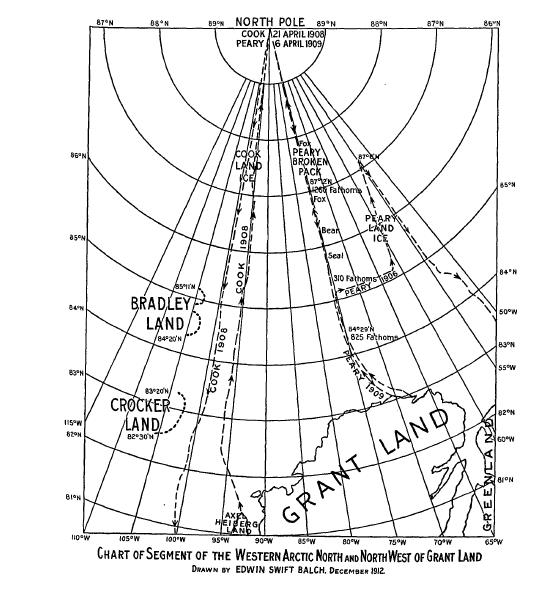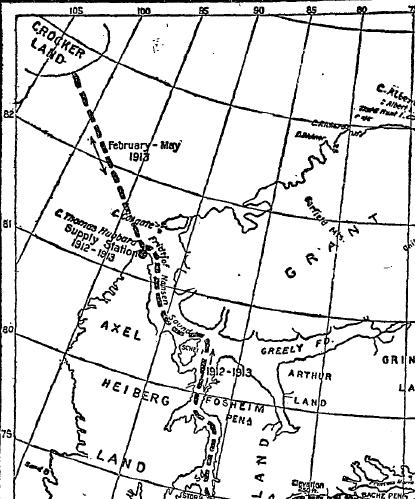Crocker Land April 3, 2011
Author: Beach Combing | in : Modern , trackback
Where do good bizarrists go when they die: why to Crocker Land, of course. And where is this anomalist’s World of Cockayne? Well, unusually for such a fantastical place we can be exact: it stands at 83 degrees N, longitude 100 degrees. Hell, Heaven, Eden and Purgatory never enjoyed these kinds of specifics.
And how was it discovered? Well, here is the story…
In 1906 the American explorer Robert Peary found himself on Axel Heiberg Island, a part of the Canadian Arctic archipelago named for, of all things, a brewery owner. Axel Heiberg was too cold even for the Inuit in the early twentieth century and so Peary was one of the first explorers to actually make it this far north. And arriving at the end of the island he was treated to a marvelous and quite unexpected view. Far off on the horizon to the north west – he estimated over a hundred miles distant, he spotted a large island that he named Crocker Land after George Crocker, an arctic nut who had sponsored Peary to the tune of 50,000 dollars.
Peary brought news of Crocker Island home and excitement about this extraordinary land grew and grew, so much so that, in 1913, the Crocker Land expedition was launched with
‘provisions for four white men, their helpers, and their dogs: a power boat, a moving picture machine, instruments for all kinds of records, a physician, a cook and cameras for use whenever a moving picture machine would not be available.’
The North West passage had been proved an illusion, the southern continent had been given the coup de grace by Cook, but on Crocker Land the last lovers of mystery could find whatever their imagination had to offer them. Hell, there was even absurd talk about a new race of men on this most mysterious Crocker continent…
Unfortunately, the mission was a disaster from beginning to end. A drunk captain almost sunk the ship with the crew and supplies near Greenland. When the party set off across the frozen sea several members had to be sent back as they became frost bitten. On the return journey one of the party shot another member, allegedly over a quarrel concerning sleigh dogs. Then, finally, suffering from Beachcombian levels of bad luck it took four years to get the party back to the States.
And Crocker Land? Well, it was sighted, kind of..
April 21st [1914] was a beautiful day; all mist was gone and the clear blue of the sky extended down to the very horizon. Green was no sooner out of the igloo than he came running back, calling in through the door, ‘We have it!’ Following Green, we ran to the top of the highest mound. There could be no doubt about it. Great heavens! What a land! Hills, valleys, snow-capped peaks extending through at least one hundred and twenty degrees of the horizon. I turned to Pee-a-wah-to anxiously and asked him toward which point we had better lay our course. After critically examining the supposed landfall for a few minutes, he astounded me by replying that he thought it was poo-jok (mist) [i.e. a fata morgana]. E-took-a-shoo offered no encouragement, saying, ‘Perhaps it is.’ Green was still convinced that it must be land. At any rate, it was worth watching. As we proceeded, the landscape gradually changed its appearance and varied in extent with the swinging around of the Sun; finally at night it disappeared altogether. As we drank our hot tea and gnawed the pemmican, we did a good deal of thinking. Could Peary with all his experience have been mistaken? Was this mirage which had deceived us the very thing which had deceived him eight years before? If he did see Crocker Land, then it was considerably more than 120 miles away, for we were now at least 100 miles from shore, with nothing in sight.’
Peary had, indeed, been mistaken, something the party gradually came to accept.
To increase our latitude we set a more northerly course on the 23d and 24th, with a variation of 178 degrees westerly. Observations on these two days put us ahead of our dead-reckoning in latitude 82 degrees 30 minutes, longitude 108 degrees 22 minutes, 150 miles due north-west from Cape Thomas Hubbard. We had not only reached the brown spot on the map, but we were thirty miles in-land! You can imagine how earnestly we scanned every foot of that horizon – not a thing in sight, not even our almost constant traveling companion, the mirage. We were convinced that we were in pursuit of a will-o’-the-wisp, ever receding, ever changing, ever beckoning.
The party only just made it back across the melting pack ice and Crocker Land remained unconquered and, what is better, unconquerable…
Now a question: what would you rather have named after you: a lump of God forsaken unpopulated rock or a fata morgana that promises new races of men, sherbet creams, sunlit valleys and a ski slope down to the North Pole?
Lucky Crocker.
Any other illusory realms: drbeachcombing AT yahoo DOT com
***
4 April 2011: KMH writes in with a reference that questions Peary’s reliability as a witness, particularly over a sighting of Jesup Land. There is also, of course, the problem of whether Peary really got to the North Pole as he claimed to have done or, perhaps better, whether he deliberately or unknowingly misled the international scientific community. Thanks KMH!
29 Nov 2014: Leif writes in ‘Peary was not mistaken. Crocker Land was a lie, pure and simple. Peary claimed to have seen Crocker Land twice– on 24 & 26 June 1906. But his diary from the 1906 expedition doesn’t mention Crocker Land, and the entry for 26 June 1906 explicitly states: ‘No land visible’. <a href=’http://www.dioi.org/cot.htm#crck’> [Rawlins, Dennis. “Contributions”. Accessed 2014-11-13.] </a>
The talk of a ‘new race of men’ waiting to be discovered on Crocker Land was hyperbole, but not entirely absurd. Etah, Greenland– the base for several of Peary’s polar expeditions as well as for Donald MacMillan’s 1913 expedition to Crocker Land– was home to an Inuit tribe that had been isolated for quite some time. So long in fact that knowledge of the hunting bow was forgotten. An isolated tribe on Crocker Land was a long shot, assuming the place existed– but still within the realm of possibility. Frederick A Cook, Peary’s nemesis, failed to find Crocker Land on his 1908 expedition to the north pole. The reason– as reported by Ahpellah and Etukishook, Cook’s companions on the journey– is that they never really got much beyond Svartevåg (Cape Thomas Hubbard). Not to be outdone, Cook discovered ‘Bradley Land’, somewhere to the north of Crocker Land. Neither appear on maps today. Note: MacMillan’s E-took-a-shoo is same as Cook’s Etukishook, and in 1913 he showed MacMillan where Cook faked his photograph of Bradley Land. [Freuchen, Peter. Vagrant viking. New York: Julian Messner, inc. 1953. p 135.] The final question: did George Crocker or Axel Heiberg wind up with the better namesake? Crocker has the romantic edge, but that comes with the territory when the expedition to find your continent is associated the term ‘ill-fated’. In contrast, Otto Svedrup’s 1899-1902 expedition was boring. Nobody lies, nobody dies, nobody even goes hungry– though they must have gotten sick of eating lutefisk. And Norwegian polar expeditions were financed on a shoestring. Considering Heiberg’s name still appears on maps, he probably got the better value for his kroner.’ Thanks, Leif




